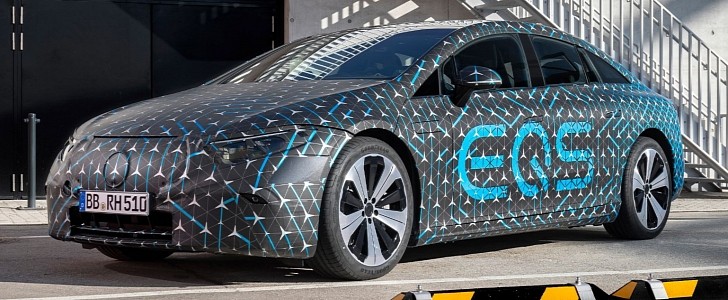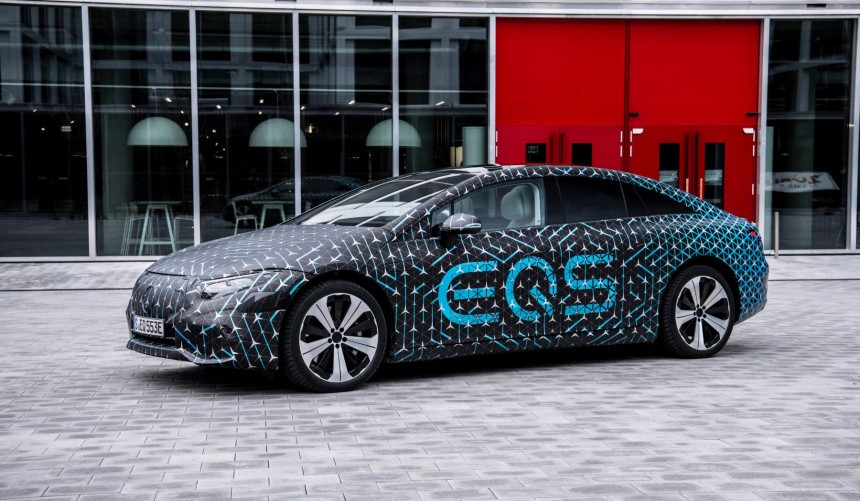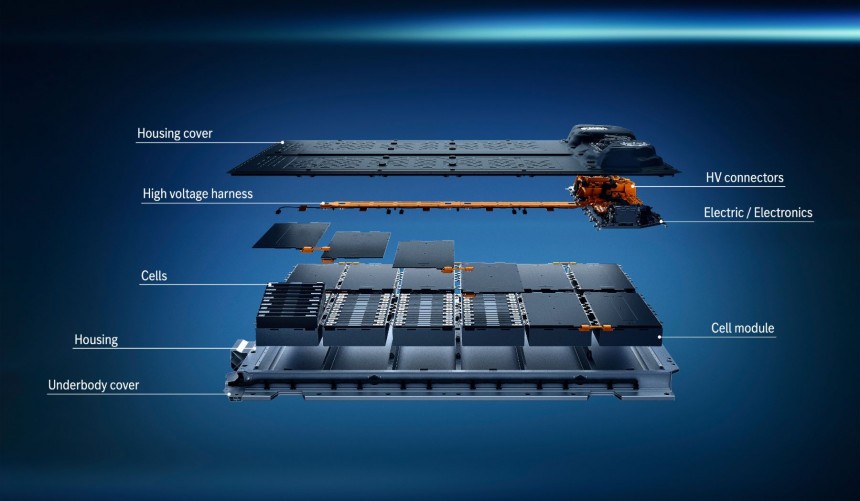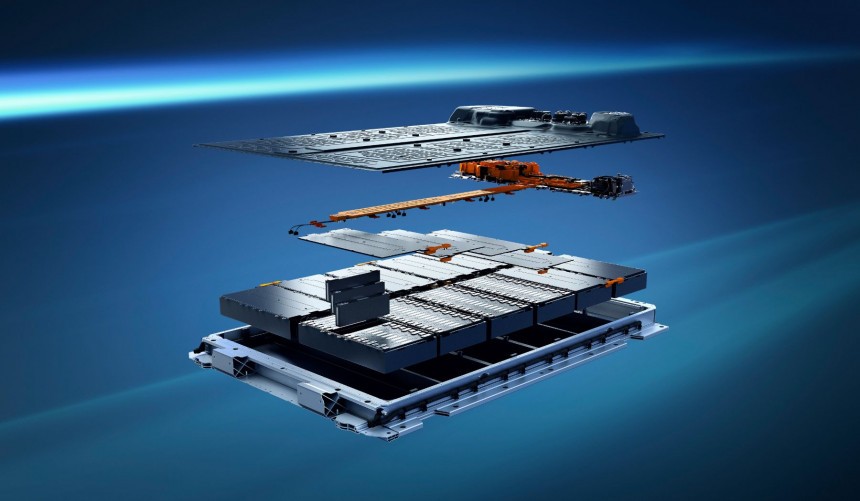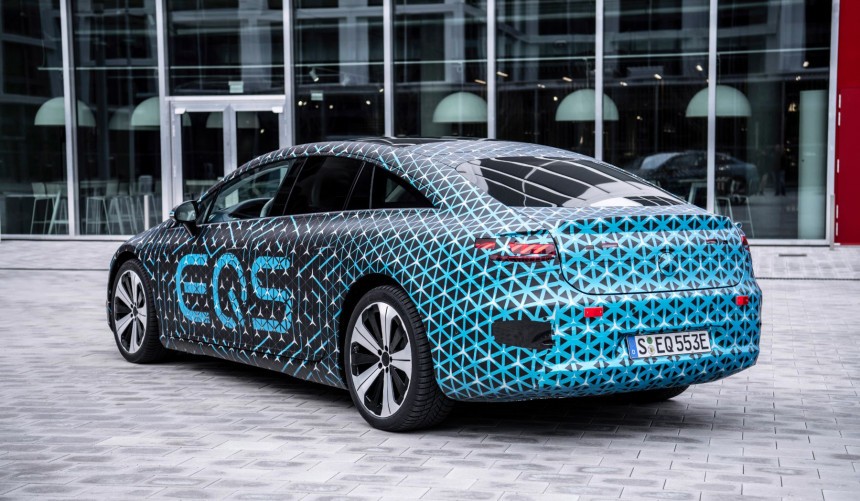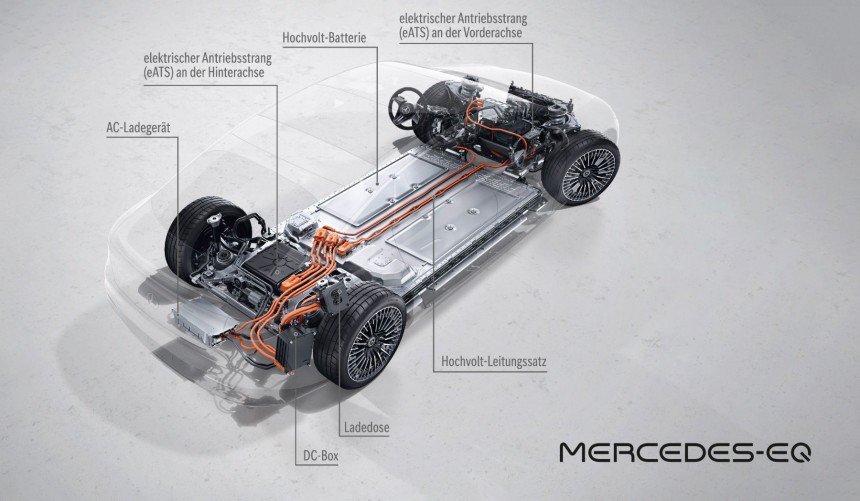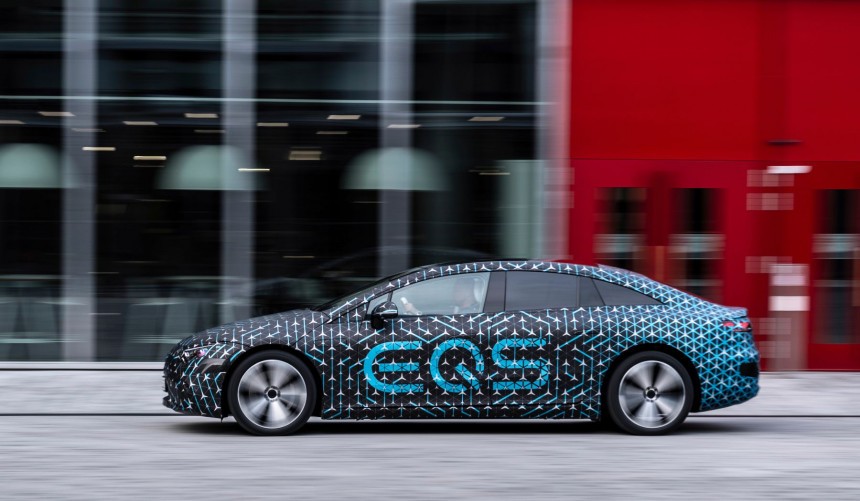Before the official unveiling scheduled for April 15th, the Stuttgart-based manufacturer has been revealing bits and pieces of information about its upcoming EV flagship, the luxurious EQS. Among other details, the most recent press release features information about the powertrain along with astonishing figures for a 400-volt architecture.
In September 2019, at the International Motor Show held in Frankfurt, Germany, Mercedes unveiled the gorgeous Vision EQS concept that blew our minds. Along with Audi’s e-tron GT concept revealed a year earlier, it signaled a bright future for German EVs.
While the production version of e-tron GT closely resembles the concept, the same can’t be said about the EQS. The Mercedes model seems to look more like an anemic version of the beefed-up, futuristic concept, even if the camouflage liveries, which are set to come off next week, conceal some of the finer details.
Still, the arguably dull yet aerodynamically efficient exterior comes second to the interior, which is amazing all across the board—especially the dashboard that houses the humongous MBUX MBUX Hyperscreen.
As for the underpinnings, we find nothing particularly revolutionary at first glance. The car is built on the all-new MEA modular platform, which might be new for Mercedes, but architectures built specifically for EVs are nothing new; even Geely has one.
Things get a lot more interesting when we look at the lithium-ion battery packs, particularly the long-range version with a usable energy content of 107.8 kWh. For comparison, the e-tron GT’s long-range battery packs 85 kWh.
Mercedes tells us that, combined with the vehicle’s incredibly efficient aerodynamics and power management systems, it should provide an estimated range of up to 478 miles (770 km).
That’s more than any Tesla model currently on sale and more than twice the range of the e-tron GT or Porsche Taycan.
Yes, this figure is a product of the notoriously generous WLTP test cycle, and we can expect the official estimated range to drop once the car undergoes EPA tests, but I’m betting it won’t drop below 450 miles (724 km) which is still better than any BEV you can buy right now.
The standard pack will have 90 kWh, but the manufacturer hasn’t revealed the estimated range figure for this version yet.
It did tell us is that it’s comprised of ten pouch cells, meaning that they are fitted inside a flexible, bag-like cover made of aluminum and a second, insulating foil. The long-range pack features twelve prismatic (or hard case) cells with a strong aluminum housing.
Both packs use an intelligent thermal management system that should provide for faster charging times. According to the WLTP cycle, Mercedes estimates that using a 200 kW DC fast charger, the EQS can gain up to 186 miles (300 km) of range in just 15 minutes.
Considering that the EV uses a conventional 400-volt architecture, these figures are extremely surprising, especially since the Audi e-tron GT and Porsche Taycan also take 15 minutes to add the same range using a 270 kW DC fast charger, even though they feature 800-volt architectures.
Kia and Hyundai’s recently revealed EV6 and IONIQ 5 also use a state-of-the-art 800-volt electrical system, and according to the same WLTP cycle, their significantly smaller packs can gain 186 miles (300 km) of range in 13.5 minutes.
These numbers mean that the battery packs and management system developed internally by Mercedes are extremely efficient; just imagine what charging times they’re going to produce when the company switches to 800 volts.
As for the 245-kW (328-hp) drivetrain, it contains a permanently excited synchronous motor, transmission, and differential, all mounted on the rear axle.
4MATIC models get an additional motor on the front axle, increasing total output to a healthy 385 kW (516 hp). Unfortunately, all that power will mean fast acceleration to the land of mediocrity since the top speed is limited to 124 mph (210 kph).
However, don’t forget that this is a car built for range and comfort, so its drivers shouldn’t mind ICE-powered relics with half the power whizzing past them on the Autobahn.
The motors might be limited in terms of speed, but they promise to excel when it comes to energy recuperation. The EQS 4MATIC will be able to regeneratively brake at up to 290 kW, which is 25 kW more than what a Taycan achieves.
Some were quick to criticize Mercedes for its 400-volt architecture since the industry is slowly but surely switching to 800 volts. But as the figures show, its engineers managed to maximize this system's efficiency to a point where it exceeds current 800-volt EVs in terms of range and energy recuperation while also seemingly matching their charging times.
It remains to be seen if the EQS is as good as advertised and if it can become a legitimate “Tesla-killer” once it actually hits the streets in production form.
The official reveal is scheduled for April 15, so stay tuned for more details and official images of the final production version.
While the production version of e-tron GT closely resembles the concept, the same can’t be said about the EQS. The Mercedes model seems to look more like an anemic version of the beefed-up, futuristic concept, even if the camouflage liveries, which are set to come off next week, conceal some of the finer details.
As for the underpinnings, we find nothing particularly revolutionary at first glance. The car is built on the all-new MEA modular platform, which might be new for Mercedes, but architectures built specifically for EVs are nothing new; even Geely has one.
Things get a lot more interesting when we look at the lithium-ion battery packs, particularly the long-range version with a usable energy content of 107.8 kWh. For comparison, the e-tron GT’s long-range battery packs 85 kWh.
That’s more than any Tesla model currently on sale and more than twice the range of the e-tron GT or Porsche Taycan.
Yes, this figure is a product of the notoriously generous WLTP test cycle, and we can expect the official estimated range to drop once the car undergoes EPA tests, but I’m betting it won’t drop below 450 miles (724 km) which is still better than any BEV you can buy right now.
It did tell us is that it’s comprised of ten pouch cells, meaning that they are fitted inside a flexible, bag-like cover made of aluminum and a second, insulating foil. The long-range pack features twelve prismatic (or hard case) cells with a strong aluminum housing.
Both packs use an intelligent thermal management system that should provide for faster charging times. According to the WLTP cycle, Mercedes estimates that using a 200 kW DC fast charger, the EQS can gain up to 186 miles (300 km) of range in just 15 minutes.
Considering that the EV uses a conventional 400-volt architecture, these figures are extremely surprising, especially since the Audi e-tron GT and Porsche Taycan also take 15 minutes to add the same range using a 270 kW DC fast charger, even though they feature 800-volt architectures.
These numbers mean that the battery packs and management system developed internally by Mercedes are extremely efficient; just imagine what charging times they’re going to produce when the company switches to 800 volts.
As for the 245-kW (328-hp) drivetrain, it contains a permanently excited synchronous motor, transmission, and differential, all mounted on the rear axle.
However, don’t forget that this is a car built for range and comfort, so its drivers shouldn’t mind ICE-powered relics with half the power whizzing past them on the Autobahn.
The motors might be limited in terms of speed, but they promise to excel when it comes to energy recuperation. The EQS 4MATIC will be able to regeneratively brake at up to 290 kW, which is 25 kW more than what a Taycan achieves.
It remains to be seen if the EQS is as good as advertised and if it can become a legitimate “Tesla-killer” once it actually hits the streets in production form.
The official reveal is scheduled for April 15, so stay tuned for more details and official images of the final production version.
